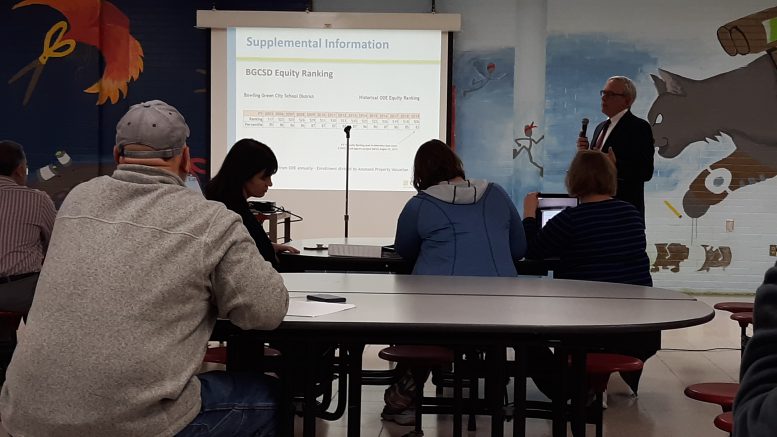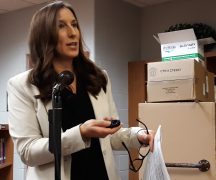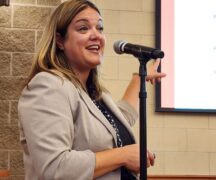By JAN LARSON McLAUGHLIN
BG Independent News
A glimmer of hope has gotten dimmer for one state funding option for Bowling Green City Schools.
During a presentation last month, one of the state funding options for school facilities looked promising … until a task force member asked more questions.
The Bowling Green district is at least a decade down on the list for funding from the Ohio Facilities Construction Commission. So when Steve Roka, senior planning manager with the OFCC, met with the district’s finance task force and presented the option of funding through the state’s Exceptional Needs Program, it sounded worth pursuing.
However, when Roka answered follow-up questions through email from task force members, the chance for funding anytime soon looked more remote.
Roka said during the meeting that ENP funding typically covers only the very worst buildings in the state – such as those with dangerous electric systems. The funding can only be used for new buildings, not renovations.
David Conley, the district’s consultant through Rockmill Financial, referred to the ENP as a “beauty contest,” with the ugliest building in the state winning.
Roka presented the ENP option as a way Bowling Green could accelerate possible state funding. And many felt that at least one building in the Bowling Green district might be in poor enough shape to be worthy of those funds.
“It sounded like we could apply for and get funding in that program,” Conley said. “It sounded good to me, too.”
But when task force members asked further questions about the Exceptional Needs Program, the chances of that funding seemed to disappear. One task force member asked about the pending applications, the deadline for submission, and the timeline for a project.
Roka responded that there are currently no ENP applications pending review. Roka added that the OFCC is not seeking new applications for the ENP.
“Because of the number of districts eligible for funding through our primary program – the Classroom Facilities Assistance Program – ENP applications are not being received by OFCC for the current planning cycle. No determination has been made as to when OFCC will reopen the application process for the ENP program,” Roka wrote.
The Exceptional Needs Program funding may have been a stretch anyway for Bowling Green School District. To qualify, a school facility must be in horrendous condition.
“The building has to be putting students in harm’s way,” Conley said earlier this week.
Not to mention – the funding just isn’t there, he added.
“The state doesn’t have money for any specialty programs, unless it’s already in the pipeline,” Conley said. “They are not even accepting applications.”
That could change, of course, if the state legislature provides more funding. But even if that occurred, the line for funds would be long.
“There’s a whole list of other school districts who would like that,” Conley said.
There are other funding programs through the OFCC, which is responsible for dispersing state funding to help school districts pay for renovating or constructing new buildings.
The district could start working on the Expedited Local Partnership Program funding route now, Roka said. The state funding still won’t be available now, but the district could put its building expenses toward its share of the state program, he said.
A task force member asked about the certainty of the funding in years to come.
“It’s a promise from the state – not a guarantee,” Roka said.
“There’s more need than we have funds to go around,” he said.
Through the ELPP, the district would have to come up with the financing for the project, with the state reimbursing the district for its portion later.
“It’s really undefined how far out in the future that will be,” Conley said.
The district would have to build according to OFCC guidelines, he added.
Bowling Green school officials and district residents continue to be frustrated over the ranking it has received for funding based on a formula of their enrollment divided by the assessed property valuation.
The ranking puts Bowling Green’s ranking at 506th in the state – meaning funding would likely not be available for at least another 10 years through the standard OFCC funding program. There are currently about 100 other school districts already waiting in line for the OFCC funds.
“You’re at least 10 years away,” Roka said. “That can change. It could increase, it could decrease.”
Roka said some districts have challenged the rankings, but not successfully.
“We are required to follow that formula,” which puts poor districts ahead of wealthy ones, he said.
Conley agreed that appealing the ranking would be a futile effort.
“We’re not the only district penalized by the formula,” he said. “They know it’s not a perfect formula,” but the state is sticking with it.
The formula puts the district in the 83 percentile – meaning the state would pick up 17 percent of the construction costs and the district would be responsible for 83 percent.
That is an improvement from a few years ago, when the formula had the state picking up just 13 percent of the costs.
That formula is based on the value of the property in the school district, divided by the number of students.
“The higher the value per student, the lower your ranking,” Conley said.
So that number is constantly changing, since the property values shift and enrollment numbers fluctuate. Plus, since the state funds six to 10 school districts a year, those districts are taken out of the comparison group – which then affects the ranking of the districts still waiting, Conley explained.
Conley cautioned against the Bowling Green district waiting to proceed with buildings in hopes of the state portion continuing to increase.
“It’s not a safe assumption to say that’s going to be a continuing trend,” he said.
At the next meeting of the finance task force on Dec. 17, at 7 p.m., Conley plans to discuss the options for state funding – and analyze the pros and cons of each option.
“The state program is a really important decision we have to make,” he said.





